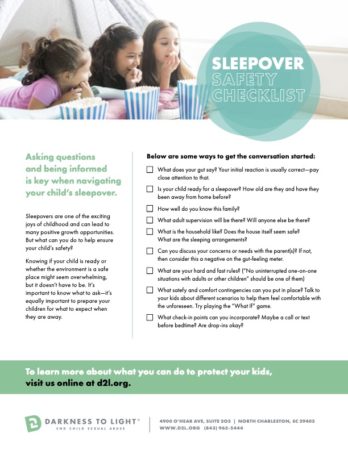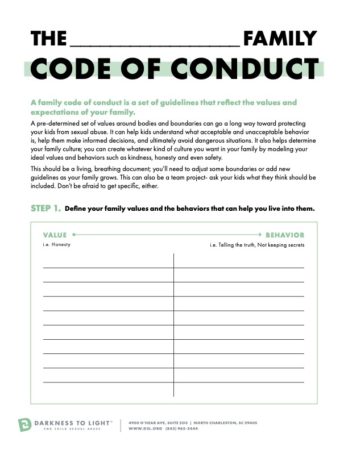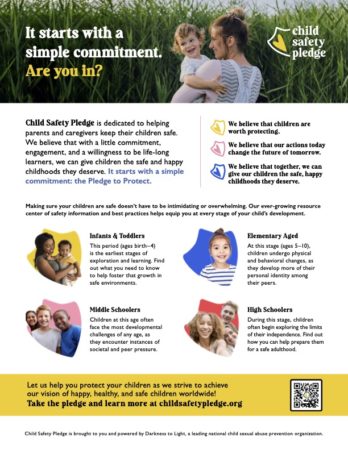Keeping children safe is something that every good parent and caregiver strives to do.
From the moment they enter our lives, we are navigating obstacles that affect their emotional, physical, and mental well-being.
Danger may come from the physical environment around them or from the activities that they enjoy. We may be trying to shield them from peer pressure, bullying, and other interactions that affect their mental health. Or we may be faced with addressing physical or sexual abuse because research shows that the greatest risk to children doesn’t come from strangers but from friends and family.
Our Family Safety Toolkit
As a parent or caregiver, there are a lot of things to think about when keeping your kids safe. In partnership with Child Safety Pledge, our newest platform, we have put together a Family Safety Toolkit to help you. Using these tools can help you have age-appropriate conversations with your children about a range of issues; from safe sleepovers and peer pressure to creating a family code of conduct and talking to your children about safety from sexual abuse.
Are you a parent or caregiver?

- Your children’s safety is at the top of your mind and our’s too! That’s why we’ve developed an ever-growing hub of information at Child Safety Pledge filled with all the things you need to know or keep in mind to ensure your kids are safe. Explore all the content and then be sure to take the Pledge to Protect.
2. A pre-determined set of values around bodies and boundaries can go a long way toward protecting your kids from sexual abuse. It can help kids understand what acceptable and unacceptable behavior is, help them make informed decisions, and ultimately avoid dangerous situations. We have created a Family Code of Conduct for you to fill out – as a family. This should be a living, breathing document that you’ll need to adjust some boundaries or add new guidelines as your family grows. Make it a team project – ask your kids what they think should be included.
3. Sleepovers are one of the exciting joys of childhood and can lead to many positive growth opportunities. But what can you do to help ensure your child’s safety? Use our Sleepover Safety Checklist (*each box can be checked off as you go!). Be sure to share it with the parent who is hosting the sleepover. If that is you, then be sure to share it with the parents of the children coming to your home.
4. Having age-appropriate, open conversations about our bodies, sex, and boundaries is an important step in protecting children. Our short, thirty-minute, online training – Talking with Children about Safety from Sexual Abuse is a great way to learn how to talk about personal safety and sex with your child and create a protective bond. It will also instill knowledge that makes children and teens much less vulnerable to child sexual abuse.
Do you work with families in a school or youth serving organization? 
- We’ve developed an ever-growing hub of information at Child Safety Pledge, filled with all the things parents and caregivers need to know or keep in mind to ensure kids are safe. Explore all of the content, take the Pledge to Protect yourself, and then share it with others.
- A pre-determined set of values around bodies and boundaries can go a long way toward protecting kids from sexual abuse. It can help kids understand what acceptable and unacceptable behavior is, help them make informed decisions, and ultimately avoid dangerous situations. Have the families you work with complete our Family Code of Conduct. This should be a living, breathing document that they can adjust boundaries or add new guidelines as their family grows. This should be a team project- have the adults include the kids and ask them about what they think should be included.
- Sleepovers are one of the exciting joys of childhood and can lead to many positive growth opportunities. But how do you help ensure a child’s safety? Use our Sleepover Safety Checklist (*each box can be checked off as you go!). Share it with the parents you know.
- Having age-appropriate, open conversations about our bodies, sex, and boundaries is an important step in protecting children. Our short, thirty-minute, online training – Talking with Children about Safety from Sexual Abuse is a great way to learn how to talk about personal safety and sex with children and create a protective bond. It will also instill knowledge that makes children and teens much less vulnerable to child sexual abuse. Take the training yourself and then share it with the parents and caregivers that you work with.
Happy, healthy, and safe childhoods for all children is our goal, but that won’t happen on its own. It’s our responsibility as parents, caregivers, and safe adults to come together to create a world that’s safe for kids. It can start with our Family Safety Toolkit.




